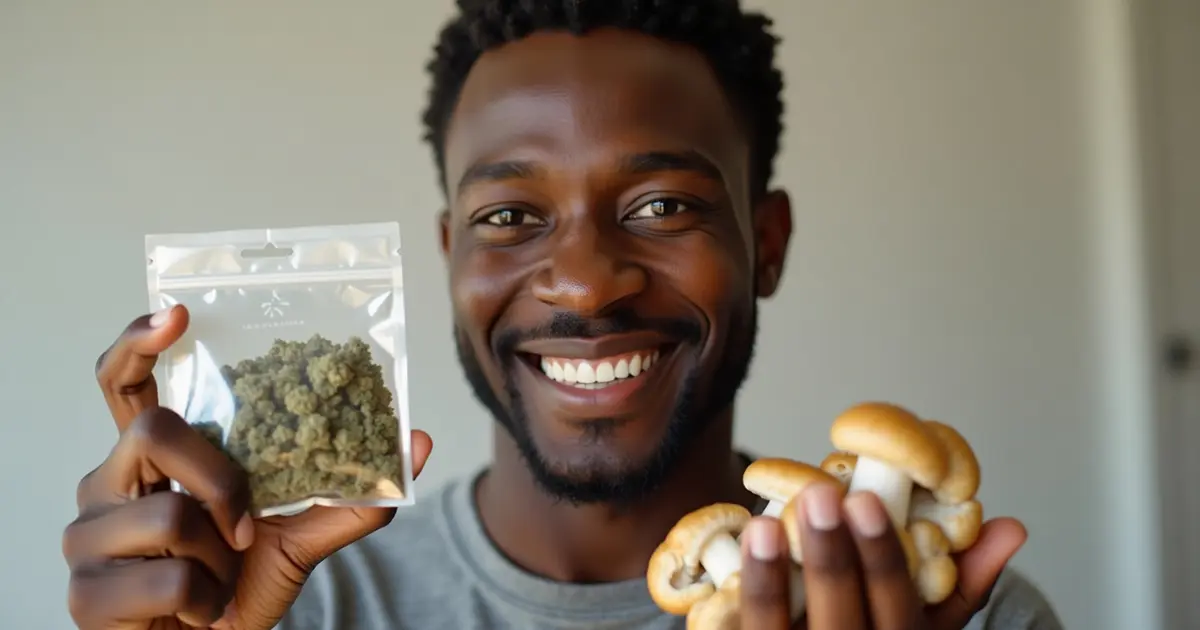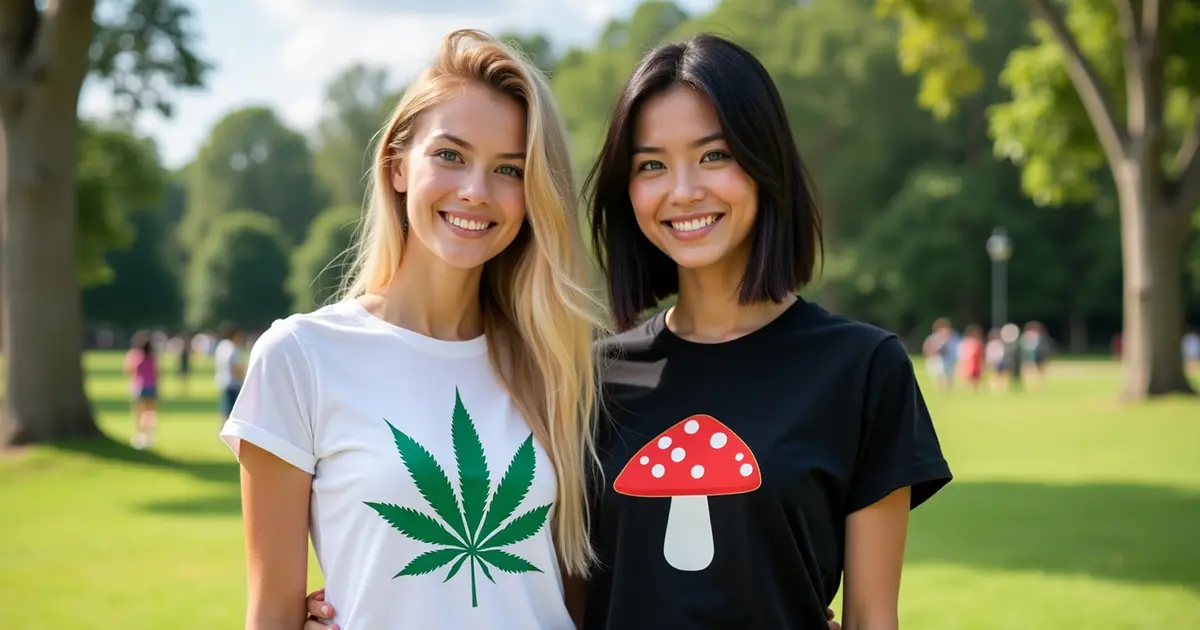Can You Mix Shrooms And Weed? Effects And Safety Tips

Mixing shrooms and weed is a common question among people curious about altering their consciousness, deepening a trip, or simply smoothing the edges of a psychedelic experience. In short: yes, many people do mix weed and shrooms, but the effects are unpredictable and the combination can both intensify positive sensations and increase risks — especially when dose, timing, mindset, or underlying health issues aren’t carefully considered. This guide walks through what science and user reports say, how mixing weed and shrooms changes the experience, the biggest safety concerns, practical harm-reduction tips, and smart next steps — including where to find lab-tested cannabis products if you choose to consume responsibly.
How Shrooms And Weed Interact: The Basics
Psilocybin-containing mushrooms (commonly called “shrooms”) and cannabis work on different neurochemical systems. Psilocybin is a serotonergic psychedelic: when metabolized to psilocin it primarily affects serotonin 2A (5-HT2A) receptors, producing altered perception, visual changes, and shifts in thought and emotion. Cannabis (THC/CBD) acts on the endocannabinoid system, changing sensory filtering, anxiety levels, and mood. When used together, cannabis can modulate how a psychedelic trip unfolds — often changing intensity, emotional tone, and perceptual features. The exact mechanism is still being researched, but real-world reports and some studies show cannabis tends to alter the quality of the psychedelic experience rather than create wholly new effects.
Short-Term Effects You Might Notice When Mixing Weed And Mushrooms
People’s experiences vary widely, but common short-term outcomes reported when mixing dried weed flower and mushrooms include:
- Amplified visuals and emotions. Cannabis — especially THC-rich strains — often increases visual vividness, emotional depth, and the sense of awe or “mystical-type” experience that psychedelics can produce. Some controlled studies and surveys report higher scores on measures like ego-dissolution, visual alterations, and mystical experience when cannabis is used during a psychedelic session.
- Faster emotional swings. Cannabis can make mood shifts feel sharper — what began as euphoria can turn into anxiety more quickly for some people.
- Reduced nausea for some users. Anecdotally, cannabis sometimes eases the stomach upset that can occur on the come-up from dried shrooms. But this is not universal.
- Increased risk of a “bad trip.” The combination may raise the chance of panic, paranoia, or overwhelming cognitive loops for sensitive individuals. Psychologically challenging experiences can be more intense when two mind-altering substances interact.
Why People Mix Weed And Shrooms
Users report mixing weed and shrooms for several reasons:
- To ease nausea or physical discomfort during the mushroom come-up.
- To intensify or deepen the psychedelic experience (visuals, emotional insights, or “mystical” moments).
- To smooth transitions: some use a little cannabis later in a trip to soften the comedown or to help with re-entry into everyday consciousness.
- Curiosity, ritual, or social norms at festivals/ceremonies where both substances are common.
While there are perceived benefits, the same variables that make mixing attractive (amplification, altered perception) also create unpredictability — which is the core safety problem.
What The Research Says About Risks — Key Findings
Research on cannabis-psychedelic co-use is still limited, but emerging studies and reviews give us cautious signals:
- Cannabis can intensify mystical and perceptual aspects of psychedelic trips. Controlled and survey-based research finds higher ratings of visual alterations, ego-dissolution, and mystical-type experiences when cannabis is used with psychedelics. That intensification can be sought after, but it can also raise risk of overwhelming experiences.
- Co-use may be associated with higher cannabis dependence in some samples. Recent research has found that people who regularly co-use cannabis and psilocybin report higher measures of cannabis dependence or heavier cannabis use compared with cannabis-only users — an association that merits attention though causality is not established. University of Colorado Boulder
- Effects vary by dose, timing, strain (THC vs. CBD), and individual vulnerability. Reviews emphasize the heterogeneity of effects: high-THC strains are more likely to amplify anxiety and perceptual changes, while CBD may have anxiolytic properties that could theoretically blunt an anxious edge — though clinical data are limited.
- There is no large body of clinical trials guiding safe mixing. Most evidence is observational, survey-based, or from small studies — meaning harm-minimization should be grounded in caution, not confident rules.
Major Safety Concerns When Mixing Weed And Mushrooms
If you’re considering mixing, know the top risks:
- Heightened anxiety, paranoia, or panic: THC can worsen anxiety in susceptible people and may intensify challenging psychedelic effects.
- Unpredictable psychological reactions: prior history of trauma, unresolved psychiatric conditions, or a family history of psychotic disorders increases risk. Psychedelics and high-THC cannabis can both precipitate psychotic-like experiences in vulnerable people.
- Dependence and altered use patterns: co-use has been linked to more frequent cannabis use and higher dependence scores in some studies.
- Physical safety risks: impaired motor function and judgment make driving or operating machinery dangerous; combining substances increases those impairments.
- Legal risk: psilocybin remains controlled federally in the U.S. in many places; cannabis legality varies by state. Be informed about local laws.
Practical Safety Tips For Mixing Weed And Mushrooms
If someone decides — knowingly and legally — to mix weed and shrooms, the following harm-reduction practices lower risk:
1. Start Low, Go Slow
- If you’ve never combined them, don’t. If you must, use a low dose of mushrooms and a small, familiar amount of cannabis. Wait to see how each substance affects you separately before combining.
2. Use Cannabis Strategically (If at All)
- Many people find that waiting until the peak to try a small puff can be less destabilizing than smoking right at the beginning. Others recommend using cannabis later in the trip to ease nausea or to soften coming down. There’s no single rule; timing affects the experience.
3. Choose Low-THC / Higher-CBD Options If Anxiety Is A Concern
- THC is the main driver of paranoia/anxiety; CBD may be anxiolytic in some people. If you’re anxious-prone, consider avoiding high-THC strains. Clinical evidence is not conclusive, but the pharmacology suggests a safer profile for low-THC or balanced products.
4. Mindset (Set) And Environment (Setting) Matter — Greatly
- Be in a safe, familiar place with a sober, trusted sitter who can help ground you if things become difficult. Avoid public places, driving, or risky environments.
5. Avoid If You Have A Personal Or Family History Of Psychosis
- People with a history of schizophrenia, bipolar disorder with psychotic features, or first-degree relatives with psychosis should avoid psychedelics and high-THC cannabis — combining them increases unpredictability. Consult a mental health professional.
6. Watch For Drug Interactions And Medications
- If you’re on SSRIs, MAOIs, antipsychotics, beta-blockers, or other prescription medications, mixing substances can be risky. Talk to a healthcare provider before using.
7. Hydrate, Eat Light, And Have A Comfortable Space
- Physical comfort reduces the risk of panic. Keep water, gentle music, and a calm temperature. Have an exit plan (phone numbers, calming techniques).
8. Know When To Seek Help
- If someone is unresponsive, having seizures, chest pain, or persistent severe psychosis, call emergency services immediately. For severe psychological distress, a calm, grounding presence and professional help are essential.
Dosage, Timing, And Practical Scenarios
- Microdosing / Low Psychedelic Dose + Tiny Cannabis: Some users microdose psilocybin and take small cannabis doses for subtle enhancement — this is lower-risk but still carries unknowns.
- Full Dose Psilocybin + Cannabis Early: Likely to produce rapid intensification; can be overwhelming for novices. Avoid if you have anxiety-prone disposition.
- Full Dose Psilocybin + Cannabis Later (Come-Down): Some report relief from nausea or a smoother re-entry; others report reignition of strong visuals. Start with a single small puff if trying this.
There is no universal “safe” schedule. Individual neurochemistry, strain chemistry, and dose are the deciding variables.
Legal And Medical Considerations
- Psilocybin legality: Federally, psilocybin remains controlled in the U.S., though some cities/states have decriminalized or created treatment programs. Know the law where you live.
- Cannabis legality: Cannabis legality varies by state; lab-tested, regulated products are safer than unregulated material. Buy from licensed dispensaries where possible to reduce contamination and dosing uncertainty.
- Medical consultation: If you have cardiovascular conditions, psychiatric diagnoses, or are pregnant/breastfeeding, do not mix substances without medical guidance.
FAQs About Mixing Weed And Mushrooms
Q: Will cannabis “cancel” a bad trip?
A: Not reliably. For some, a small amount of cannabis calms dysphoria; for others, it worsens anxiety. If you’re prone to panic, a sober sitter and grounding techniques are safer first-line responses.
Q: Is CBD a safer option during a trip?
A: CBD may reduce anxiety for some users, but evidence is limited. CBD does not produce intoxicating effects like THC and may be preferable if you want to avoid paranoia.
Q: Can mixing lead to addiction?
A: Psychedelics are not typically associated with classic addiction, but co-use patterns have been associated with higher measures of cannabis dependence in some studies. Monitor frequency and function of use.
Bottom Line: Is It Worth The Risk?
Mixing weed and shrooms can produce uniquely profound experiences for some people — deeper visuals, emotional openings, or a smoother ride — but it also raises the unpredictability and risk of anxiety, paranoia, and heavier cannabis use over time. The safest approach is to be informed, conservative, and prepared: know your doses, control the environment, avoid mixing if you have psychiatric vulnerabilities, and consider lower-THC or CBD-focused cannabis if you do choose to combine. Remember, the science is still catching up; many recommendations are based on emerging studies and user reports rather than long-term clinical trials.
If You Choose To Use: A Quick Checklist
- Start low with both substances.
- Test each substance alone before combining.
- Use a safe, familiar setting with a sober sitter.
- Avoid high-THC strains if anxious; consider CBD options.
- Don’t drive or operate machinery.
- Know local laws and medical contraindications.
- Have emergency contacts and a plan.
Find Lab-Tested Cannabis At Get Bud Online
If you decide to consume cannabis as part of a mindful, legal plan, choose lab-tested products from a trusted US-based online cannabis dispensary. At Get Bud Online, we carry a range of tested flower, vape cartridges, and CBD-forward options so you can pick products with known THC/CBD levels — an important harm-reduction step if you’re considering mixing weed and shrooms. Browse our selection, read lab reports, and shop responsibly: visit Get Bud Online to find products that match your comfort level and reduce surprises. (Not medical advice — consult a healthcare provider if you have health concerns.)
Final Thought
Mixing weed and shrooms is not an all-or-nothing verdict — it’s a spectrum of experiences shaped by dose, substance quality, personal history, and environment. Treat the combination with respect, prioritize safety, and make choices that minimize harm. If you’re curious but nervous, start by learning more, talking with knowledgeable peers, or speaking with a medical professional. If you want lab-tested, clearly labeled cannabis products to help reduce one variable in the mix, check out Get Bud Online and pick products designed for predictable dosing and responsible use.
This article is for informational purposes only and is not medical advice. Psilocybin remains controlled under federal law in many U.S. jurisdictions. Consult a licensed healthcare professional before using controlled substances, especially if you have a medical condition or take prescription medication.
REFERENCES:
Hammell. (2023, February 23). What Happens If You Mix Cannabis With Psilocybin?. Available at: https://extractionmagazine.com/2023/02/23/what-happens-if-you-mix-cannabis-with-psilocybin/
J. Piercey, E. Hetelekides, H. C. Karoly. (2024, July 11). Simultaneous cannabis and psychedelic use among festival and concert attendees in Colorado: characterizing enhancement and adverse reactions using mixed methods. Available at: https://jcannabisresearch.biomedcentral.com/articles/10.1186/s42238-024-00235-x
Original story from University of Colorado Boulder. (2025, August 8). Using Cannabis and Psilocybin Together Might Increase Dependence. Available at: https://www.technologynetworks.com/neuroscience/news/using-cannabis-and-psilocybin-together-might-increase-dependence-403267


